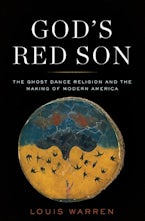- Home
- history
- body, mind & spirit
- Enchanted Ground

Enchanted Ground
The Spirit Room of Jonathan Koons
By: Sharon Hatfield
360 Pages
- Hardcover
- ISBN: 9780804012089
- Published By: Ohio University Press
- Published: November 2018
$28.95
Jonathan Koons was a fascinating 19th-century figure of the religious movement often called modern American spiritualism, and so it is surprising that Sharon Hatfield’s book Enchanted Ground: The Spirit Room of Jonathan Koons is the first full-length monograph on his mediumship. Hatfield’s work is a welcome, overdue book that is well-researched and written with vivid prose. While Hatfield is not a trained scholar of religion, that did not keep her from doing deep research into primary sources and secondary sources on spiritualism and 19th-century religion in the United States. Her writing style is clear, evocative, and keeps the reader’s interest; in that regard, her writing skills as a journalist do her a great service.
In the mid-1850s, spiritualism was quickly gaining in popularity across the United States, especially among white liberal Protestants. Emphasizing the permeable veil between the living and the dead, spiritualist mediums facilitated communication across that divide and offered comfort, reassurance, and entertainment to the living. Koons, a farmer in rural Ohio, opened what was known as his spirit room at this time, and visitors described the most remarkable séances: a lead spirit named King spoke through a trumpet, spirits played musical instruments, and spirit hands reached out and touched sitters. (Honestly, it really is surprising that no scholar had given Koons the attention of a full book.) Hatfield brings all this to life. With rich storytelling skills, she takes primary sources that describe a sitter’s experience in the spirit room and reframes them as revealing and dramatic narratives. She embeds Koons in his larger social and historical contexts with references to Emanuel Swedenborg, the Second Great Awakening, Andrew Jackson Davis, the Fox sisters, and even Johnny Appleseed.
Enchanted Ground is driven by narrative, rather than argument. Hatfield takes readers from Koons’ early life, the mediumship of Koons and his large family, through the heyday of the spirit room in Ohio, and ends with noting how his life and the lives of his children ended. She even describes what came after the spirit room on his former farm, significant since the spirits themselves said that land was special. The spectacle of his spirit-room demonstrations, visitor experiences, and the drama of skeptical investigators fill the majority of the book’s pages.
Hatfield’s work is to be lauded for decentering the Northeast in studies of the movement. In the process, she is also able to consider spiritualism, class, and regionalism. This is most clear when discussing the exposé written by Harvard-educated James Hackett Fowler and his resulting back-and-forth with Koons, published in spiritualist papers. Koons, being self-educated, was no East Coast elite, and he was not shy when it came to defending himself against accusations of fraud. Unlike the Fox sisters in New York City, he did not charge for demonstrations. He eluded the stereotypical mold of the genteel, parlor-room spiritualist. In this regard, Hatfield’s work builds on works by Catherine Albanese and others who push the field to recognize the full scope of spiritualism.
There are a few areas where readers may wish Hatfield had further analyzed Koons. One of these is gender analysis. Works such as Ann Braude’s 1989 Radical Spirits: Spiritualism and Women’s Rights in Nineteenth-Century America (Beacon Press, 1989) strongly and persuasively reveal the importance of gender dynamics and social and political power in spiritualism. Historian Brett E. Carroll turned attention to the role of masculinity in the mediumship of spiritualist John Shoebridge Williams. Koons, like the famous Davenport brothers, Ira and William, engaged in physical mediumship. The spirit demonstrations they facilitated emphasized showmanship and material action, and Hatfield compares the Davenport brothers with Koons for good reason. Female mediums, such as Jonathan’s wife, Abigail, were more likely to focus on mental mediumship, such as clairvoyance and healing. Jonathan Koons’ fantastic demonstrations are ripe for gender analysis, which would have been a rich addition to Hatfield’s book. However, by keeping her focus on the narrative, Hatfield has given readers an engaging and highly accessible read. One does not need to be a student or scholar of American religion to become engrossed in her work, and that is a real success. Experts in religion and everyday readers alike will enjoy Hatfield’s work and the questions it prompts about alternative religions and the attraction they hold.
Emily Suzanne Clark is associate professor of religious studies at Gonzaga University.
Emily ClarkDate Of Review:April 30, 2021
Sharon Hatfield is an award-winning journalist and nonfiction writer. Her interest in Appalachian letters and history led to her writing Never Seen the Moon: The Trials of Edith Maxwell and coediting An American Vein: Critical Readings in Appalachian Literature.











